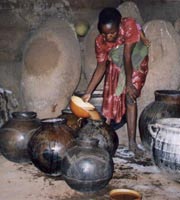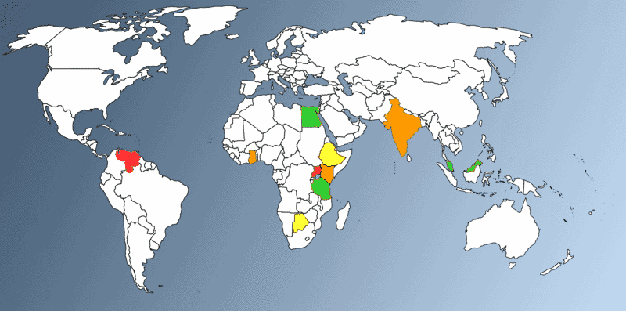

Talen:

Since the early 60’s the average consumption of alcohol of adults1 worldwide, expressed as litres of pure alcohol from beer, wine and spirits, has ranged from 4 to 6 litres per person per year. Consumption increased from 1961 until the early 1980s and then decreased to a stable level of around 5 litres per person per year.

Alcohol consumption in Europe, Africa, and the Americas peaked around the same time, in the early 1980s. Consumption in Europe has been much higher than in any other region, ranging from about 17 litres per person per year during the peak years down to a little more than 10 litres per person per year in the late 90’s.
The Americas show the second highest level of consumption, followed by Africa and the Western Pacific regions, while the South-East Asian and Eastern Mediterranean regions show the lowest level of consumption. Alcohol consumption has increased steadily in the South-East Asian and Western Pacific regions, but is stable or falling in all other regions.
Alcohol consumption levels across the world tend to converge, except for the low-consuming Eastern Mediterranean region, where the alcohol consumption remains very low because the majority of the population is Muslim. Alcohol intake is generally increasing with increasing economic development. However, it should be noted that regional averages may hide large differences between individual countries within these regions.
Table 3: Total recorded alcohol per capita consumption (15+)
This text is a summary of:
WHO
Global Status Report on Alcohol
2004
![]()

Countries can often be categorized as mainly beer, wine or spirits countries.
Table 4: Top 20 countries with highest bewerage specific adult per capita consumption
However, beverage preferences are changing. In Europe, consumption of beer is increasing and consumption of wine is decreasing. This is due to increasing imports of beverages other than those normally produced in the country. For example, in high wine producing and consuming countries, such as France, Greece, Italy, Portugal and Spain, consumption of wine is decreasing, while in non-producing countries, such as the Netherlands, the United Kingdom, Ireland and Belgium, consumption of wine is increasing.
Other fermented beverages that do not strictly fall into the usual beer, wine and spirits categories are also consumed.
Within individual countries, dramatic changes in alcohol consumption rarely occur unless there are large natural disasters or conflicts. Apparent large changes are more likely to be due to a change in the way the information is collected or to shifts between legal and illegal alcohol production
This text is a summary of:
WHO
Global Status Report on Alcohol
2004
![]()
Not all alcohol consumption is reflected in official national records or surveys. Unrecorded sources of alcohol include:
Moreover, some consumptions by nationals of one country are recorded in other countries, for instance as a result of
This imperfect recording leads to underestimates of the actual national consumption in most countries and overestimates in some such as Luxemburg where visitors and tourists account for a sizeable proportion of total alcohol consumption. This may also explain why Luxembourg has the highest recorded alcohol consumption per person in Europe.
In contrast, there are countries, for instance in East Africa, in Eastern Europe and in the former Soviet Union, where a large share of alcohol consumption goes unrecorded.
Unrecorded alcohol consumption is estimated to be at least two-thirds of all alcohol consumption in the Indian subcontinent, about half of the consumption in Africa and about one-third in Eastern Europe and Latin America.
In Europe, the estimated unrecorded alcohol consumption varies from country to country ranging from about half a litre to several litres per person per year. Unrecorded consumption is highest in the Nordic countries, particularly Norway, Sweden and Lithuania, with estimates of unrecorded alcohol consumption ranging from 25% to 65% of total alcohol consumption.
Assessing unrecorded alcohol consumption at national or local level is important for alcohol policy studies and particularly for studying the relationship between policy, consumption and alcohol-related problems.
Table 5: Estimated volume of unrecorded consumption
This text is a summary of:
WHO
Global Status Report on Alcohol
2004
![]()
In many countries, particularly in Africa, beverages are made traditionally in villages or homes through fermentation of seeds, grains, fruits, vegetables and palm trees. They are often not high in alcohol and spoil quickly.
Home-made beverages are likely to be cheaper than factory-made “branded” beverages, thus ensuring their continuing popularity, especially among poorer population groups. In some countries, such as Namibia, home-brewed beverages are the main source of alcohol and contribute to improving the economic livelihood of their producers which are often women.

Traditional forms of alcohol are usually not adequately controlled for quality or strength and can contain harmful substances. They can cause death, blindness or illness, from methanol, high alcohol content, or the deliberate addition of substances such as car battery acid or formalin. Such cases have been reported in Kenya, Zimbabwe, Bangladesh, India, and Somalia. In order to address these health problems, it is important for the state to gain control over informal production and distribition of alcoholic drinks.
Industrially produced lager-style beer is gaining in popularity in developing countries perhaps because of advertising and prestige attached to international brands. Although industrially-produced alcohol may be healthier in terms of the purity of the product, traditionally-produced beverages may be lower in alcohol, provide local employment, and preserve local culture.
Examples of the social context in which local and traditional
alcoholic beverages are produced in:
India,
Venezuela,
Malaysia,
Uganda,
Botswana,
Ethiopia,
Egypt,
Ghana,
Kenya,
Tanzania
Clickable world map providing access to local case examples:

This text is a summary of:
WHO
Global Status Report on Alcohol
2004
![]()

This summary is free and ad-free, as is all of our content. You can help us remain free and independant as well as to develop new ways to communicate science by becoming a Patron!